Italeri's 1/72 scale
B-58 Hustler
by Roland Sachsenhofer

Hobby Boss' 1/32 Spitfire Mk.Vb Trop is available online from Squadron
That the Convair B-58 Hustler is a truly spectacular aircraft can be seen at first sight. But not only the racy exterior, also the "inner values" of this more than twice as sound-fast aircraft can fascinate! I would like to substantiate this claim with a few clues, which refer to what is hidden under the heat-resistant metal of the hull.
The darkest fact about this record-breaking aircraft is probably its intended use. Against the background of the cold war, which threatens to become "hot" again and again, the B-58 was fixed on one role during its operational life: to carry the nuclear death over the cities of the Eastern Bloc as an atomic bomber. The Hustler was a main instrument of the "nuclear deterrence" of the USA in the 60s.
For some time it was with not only for a bomber unbelievable Mach 2.1 (about 2300 km/h) faster than all fighters of that time; only the MiG 21 could theoretically have caught up with it.

The development of ground-based anti-aircraft missiles finally forced it to meet a mission profile for which it had not been designed: extreme low altitude flight at supersonic speed. The resulting high wear and tear and the reduced flight performance in dense layers of air finally brought an end in 1970, after only ten years of service, when the last B-58s were taken out of service. A remarkably high accident rate as well as the exorbitantly high operating costs accelerated this process.
Convair had ventured far ahead with the concept of the B-58. In order to meet the requirement of combining a large and voluminous payload with the complex aerodynamic requirements of an aircraft operating in the high supersonic range, the idea of structurally separating payload and airframe was born.
In this way, the fuselage designed according to the wing rule remained slim and had the required relatively small diameter, while a droppable container under the fuselage contained not only the main amount of fuel but also the deadly payload in the form of a nuclear free-fall bomb.
In the later history of the mission, various payload carriers were developed and the possibility of carrying an additional four free-fall atomic bombs on suspension points under the fuselage was created; the above-mentioned concept, however, was retained.
In order to give the three-man crew an at least theoretical chance of rescue in an emergency at such high airspeeds, semi-automatic rescue capsules were developed and installed for the first time. These constructions, which opened during normal operation, locked in fractions of a second and hermetically enclosed the crew member before the capsule was shot into the airstream.
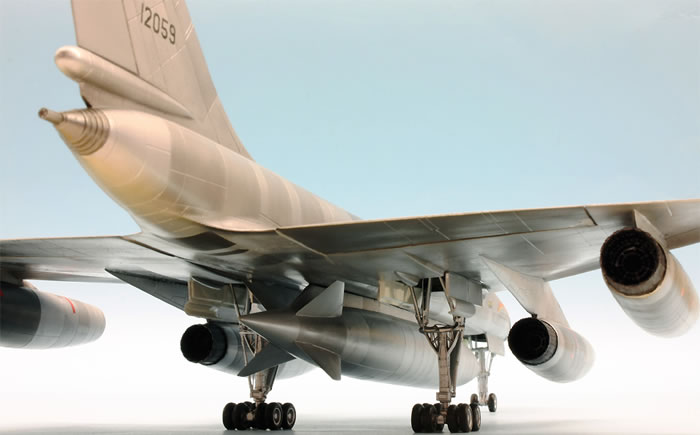
The Hustler is also a superlative in terms of loudness: The four GE J79 engines produced such infernal noise during operation that they earned the Hustler the beautiful title of the "loudest aircraft" in history.
Another novelty is also associated with sound waves, albeit of a more pleasant nature. The B-58 was also the first female voiced information system. The crew was informed of certain mission-related circumstances by the voice of a female speaker. This should have a calming and relaxing effect.
Hustlers also made history in the form of a whole series of world speed records. In 1961, the Paris-New York route was completed in the world record time of 3 hours, 19 minutes and 58 seconds
A further record was set on 16 October 1963 by the crew of Major Sidney J. Kubesch, Major John Barrett and Captain Gerard Williamson with a B-58 of the 305th Bomb Wing as part of "Operation Greased Lightning". This ship achieved a new world best time for the distance from Tokyo to London: 8 hours, 35 minutes and 20.4 seconds! This record has not been beaten until today.
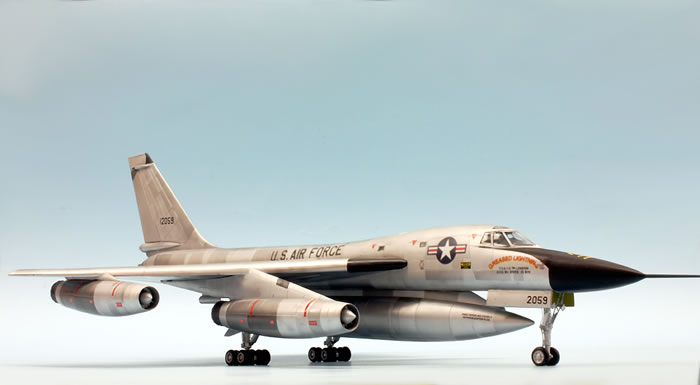
The original "Oiled Lightning" can still be admired today in the Strategic Air and Space Museum in Ashland, Nebraska. If you are interested, I may refer to this link: https://www.thisdayinaviation.com/tag/operation-greased-lightning/
A seventy-two fold downsizing of exactly this machine is also the subject of the current article: Convair B-58A-20 CF 61-2059 "Greased Lightning" is one of a total of six decal options offered in the truly outdated but still well buildable kit from Italeri.
The shapes date back to 1984, which cannot be denied. The high quality decals, whose use is unproblematic and whose effect is excellent thanks to a wafer-thin but not fragile carrier film, were added in 2011.
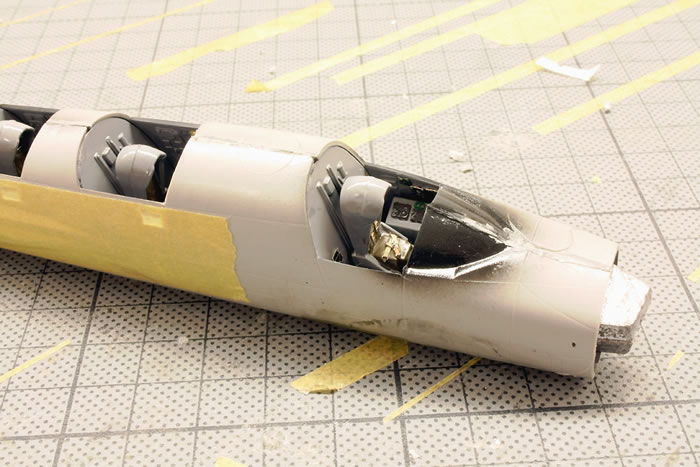
The details in the cockpits are sparse, which is no pity considering the fact that there is literally nothing to see of the two rear cockpits and very little to see of the front.I have detailed the undercarriage areas for this, which are precise, but not detailed enough. Especially at the "stork legs" of the B-58 you can let off steam at the reproduction of various lines, these then also contribute substantially to the appearance.
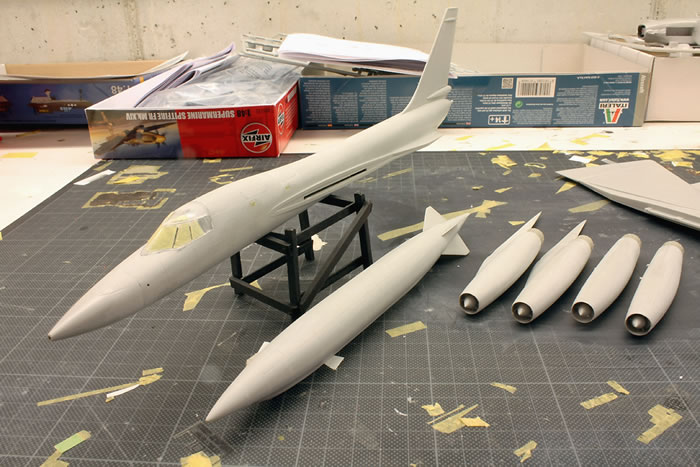
Completely new are the two landing lights on the nose wheel. These were improvised from cut-to-size transparent parts from the spare parts box. Aftermarket purchases include the metal nose cone as well as an etched strut for the two supports of the nose gear. Furthermore, the nozzles of the four engines were replaced by resin ones.
For the representation of the natural metal surfaces different Alclad II metal colours were used - as always, may I say.
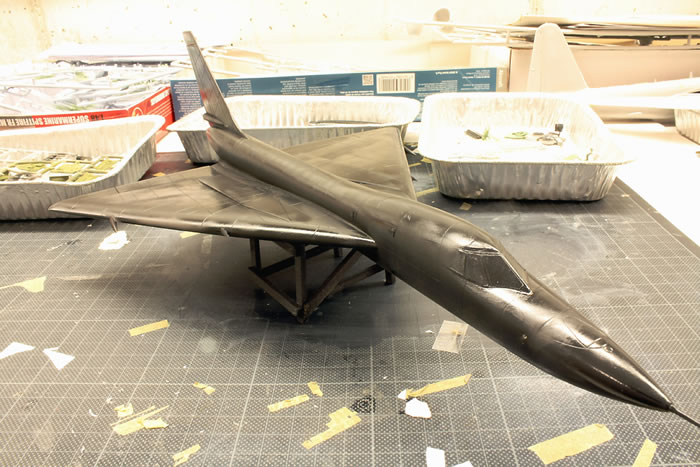
Especially with a surface like this, where you have to mask off dozens of times, I am happy about such a reliable and easy to work with product.
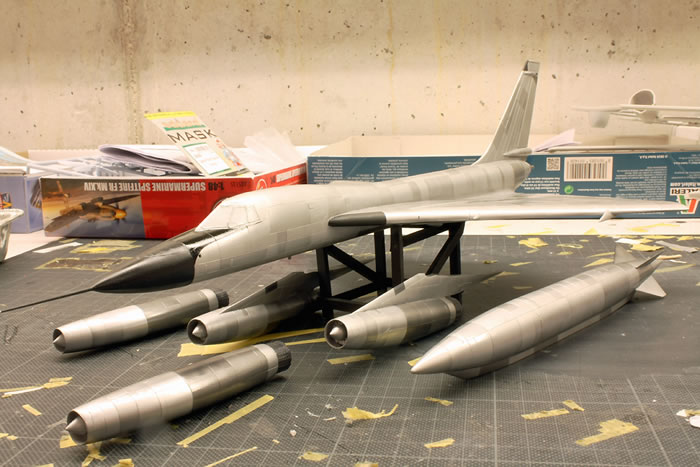
The design of the complex "metal surface" was a reasonably time-consuming but worthwhile undertaking.
The B-58 Hustler in the model stands quite impressively on the workbench - and of course also in the showcase.
Whoever is enthusiastic about the elegance and the history of the model is still very well advised with the kit from Italeri!
If you are interested in the building process, please have a look here on Scalemates:
https://www.scalemates.com/profiles/mate.php?id=10148&p=albums&album=54758
As ever, remarks will be appreciated: ro.sachsenhofer@gmx.at
Model, Images and Text Copyright ©
2020 by Roland Sachsenhofer
Page Created 10 April, 2020
Last Updated
10 April, 2020
Back to HyperScale Main Page

|
Home
| What's New | Features | Gallery | Reviews | Reference | Resource Guides | Forum |